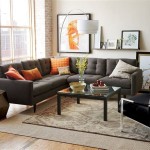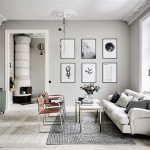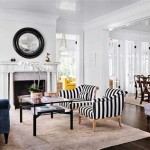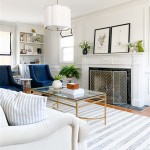Small Living Room Set Up Ideas
Designing a small living room presents unique challenges. Maximizing space, creating a functional layout, and maintaining an aesthetically pleasing environment require careful planning and execution. A well-thought-out setup can transform a cramped area into a comfortable and inviting space. Considerations must be given to furniture selection, color palettes, lighting, and storage solutions to achieve optimal results. The focus should be on creating an illusion of spaciousness and ensuring that every element contributes to both the functionality and visual appeal of the room.
Prioritizing Furniture Selection
Choosing the right furniture is crucial in small living rooms. Opting for multifunctional pieces and those designed with space-saving in mind is highly recommended. A sofa with built-in storage, a coffee table with drawers, or ottomans that can double as seating and storage offer practical solutions. Scale is also a significant factor. Oversized furniture can overwhelm a small room, making it feel even smaller. Instead, consider smaller sofas, loveseats, or sectionals designed specifically for compact spaces. Modular furniture allows for flexible arrangements and can be easily reconfigured to adapt to different needs.
Another strategy involves using furniture with exposed legs. This creates a sense of openness by allowing light to pass underneath, reducing the visual weight of the furniture. Glass or acrylic furniture can also contribute to a lighter, less cluttered feel. When selecting armchairs, consider those with slim profiles and avoid bulky designs. Floating shelves and wall-mounted cabinets are excellent storage solutions that don't take up valuable floor space. By carefully considering the size, design, and functionality of each piece of furniture, it's possible to create a comfortable and usable living room without sacrificing style.
Avoiding clutter is paramount. Before purchasing any furniture, meticulously measure the available space and create a detailed floor plan. This helps visualize the layout and ensures that the furniture will fit comfortably without obstructing movement. Prioritize essential pieces and avoid unnecessary additions that could contribute to a cluttered appearance. A minimalist approach to furniture selection can significantly enhance the feeling of spaciousness in a small living room.
Optimizing Layout and Flow
The layout of the living room should facilitate easy movement and create a comfortable flow. Arranging furniture strategically can significantly impact the perceived size of the room. Avoid pushing all the furniture against the walls, as this can actually make the room feel smaller. Instead, consider floating furniture away from the walls to create pathways and visual interest. This arrangement can help define different zones within the living room, such as a seating area and a reading nook.
Creating a focal point is another effective technique. This could be a fireplace, a large window, or a statement piece of artwork. Arranging furniture around a focal point draws the eye and creates a sense of balance in the room. The placement of the sofa should be considered carefully. In some cases, positioning it diagonally across a corner can maximize seating space and create a more dynamic layout. However, ensure that there is still ample room to move around the furniture freely.
Consider the traffic flow within the room. Pathways should be clear and unobstructed, allowing for easy movement from one area to another. Avoid placing furniture in doorways or walkways, as this can create bottlenecks and make the room feel cramped. Using rugs to define different areas can also help to create a sense of order and cohesion. A carefully planned layout can significantly improve the functionality and comfort of a small living room.
Creating a sense of verticality can also enhance the perceived size of the room. Tall bookshelves, floor lamps, and vertical artwork draw the eye upward, creating the illusion of higher ceilings. Avoid cluttering the floor with too many small items, as this can make the room feel busy and cramped. By focusing on vertical elements, it's possible to create a more spacious and airy feel.
Utilizing Color and Lighting Effectively
Color plays a crucial role in creating a sense of spaciousness in a small living room. Light and neutral colors, such as white, off-white, beige, and light gray, reflect light and make the room feel larger. Dark colors, on the other hand, absorb light and can make the room feel smaller and more enclosed. Using a monochromatic color scheme, with variations of a single color, can create a sense of harmony and visual flow.
Accent colors can be used to add pops of interest and personality to the room. However, it's important to use them sparingly, as too many colors can create a cluttered and overwhelming feel. Consider using accent colors in accessories, such as pillows, throws, and artwork. A carefully chosen accent color can draw the eye and create a focal point within the room.
Lighting is equally important. Natural light is the most effective way to brighten a small living room. Maximize natural light by keeping windows clean and unobstructed. Avoid heavy curtains or blinds that block light. Sheer curtains or light-filtering shades can allow sunlight to enter the room while still providing privacy.
Artificial lighting should be layered to create a warm and inviting atmosphere. Overhead lighting, such as recessed lights or a pendant fixture, can provide general illumination. Task lighting, such as table lamps and floor lamps, can be used to illuminate specific areas for reading or other activities. Accent lighting, such as spotlights or wall sconces, can be used to highlight artwork or architectural features. By combining different types of lighting, it's possible to create a well-lit and visually appealing living room.
Mirrors are another effective way to enhance the sense of space. Placing a large mirror on a wall can reflect light and create the illusion of a larger room. Mirrors can also be used to highlight architectural features or to create a focal point. Experiment with different mirror placements to find the most effective way to enhance the space.
Implementing Smart Storage Solutions
Effective storage is essential in a small living room to maintain a clutter-free and organized environment. Built-in storage solutions, such as shelves and cabinets, can maximize space and provide ample storage without taking up valuable floor area. Consider incorporating storage into existing architectural features, such as alcoves or niches.
Multifunctional furniture, as previously mentioned, is invaluable for storage. Ottomans with storage compartments, coffee tables with drawers, and sofas with built-in storage are all excellent options. Vertical storage solutions, such as tall bookshelves and wall-mounted shelves, can also help to maximize space and keep items organized.
Utilize vertical space by installing shelves that extend to the ceiling. This creates a visually appealing storage solution that also draws the eye upward, making the room feel taller. Consider using baskets and bins to organize items on shelves, creating a more cohesive and visually appealing look. Labeling these containers ensures that everything is easily identifiable and accessible.
Decluttering regularly is crucial for maintaining a small living room. Get rid of items that are no longer needed or used, and organize the remaining items in a way that is both functional and visually appealing. Avoid accumulating unnecessary items that can contribute to a cluttered look. By implementing smart storage solutions and decluttering regularly, it's possible to maintain a clean and organized living room, even in a small space.
Consider using under-furniture storage. Low boxes, baskets, or even custom-built drawers can slide under sofas, beds, or chairs to provide discreet storage for blankets, pillows, books, or other items. These options are particularly useful when floor space is limited.
Enhancing Ambiance with Accessories
Accessories can add personality and warmth to a small living room without overwhelming the space. However, it's important to choose accessories carefully and avoid cluttering the room with too many items. A few well-chosen accessories can make a significant impact on the overall ambiance of the room.
Rugs can define different areas within the living room and add warmth and texture. Choose a rug that is appropriately sized for the space and complements the color scheme. Artwork can add a personal touch and create a focal point. Choose artwork that is proportional to the size of the room and reflects your personal style.
Pillows and throws can add comfort and texture to the seating area. Choose pillows and throws that complement the color scheme and add a pop of interest. Plants can add life and freshness to the room. Choose plants that are appropriate for the lighting conditions and require minimal maintenance.
Personalizing the space with meaningful items, such as photographs, souvenirs, and family heirlooms, can create a sense of warmth and connection. However, it's important to display these items in a way that is organized and visually appealing. Avoid cluttering surfaces with too many small items. Instead, create curated displays that showcase your personal style and interests.
Strategically placed accessories can also help to enhance the sense of space. For example, a tall vase or a sculptural object can draw the eye upward, creating the illusion of higher ceilings. A mirror can reflect light and create the illusion of a larger room. By choosing accessories carefully and placing them strategically, it's possible to enhance the ambiance of a small living room without overwhelming the space.
Ultimately, creating a successful small living room setup involves a careful balance of functionality, aesthetics, and personal style. By prioritizing furniture selection, optimizing layout and flow, utilizing color and lighting effectively, implementing smart storage solutions, and enhancing ambiance with accessories, it's possible to transform a cramped area into a comfortable, inviting, and visually appealing space.

17 Small Living Room Ideas To Maximize Your Space Spacejoy
:strip_icc()/cdn.cliqueinc.com__cache__posts__191613__small-living-room-ideas-191613-1526001981902-main.700x0c-ab3bbf79e5664b22b0a1973abcd3a11f.jpg?strip=all)
35 Designer Approved Small Living Room Ideas

Small Living Room Decorating Ideas Designcafe

10 Stunning Small Living Room Ideas To Maximize Space

Small Living Room Ideas 3 Easy Design Strategies Spaces

Small Living Room Design Ideas Hgtv

15 Small Living Room Ideas For Maximising Your Space Livspace

Ideas For Small Living Room Furniture Placement Renovation Rooms Apartment
:max_bytes(150000):strip_icc()/154844841_1913837928767303_4703053855314656226_n-7776f09f3d67417caf5a7bd062c1acd1.jpg?strip=all)
52 Small Living Room Ideas To Maximize Space And Style

Top 10 Small Living Room Ideas For Your Home








